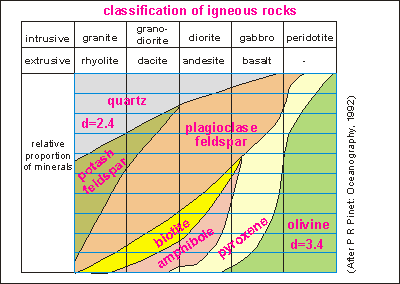The key difference between basalt and granite is that basalt is mostly occurring on ocean floors while granite is in the crust of the earth in all continents.
Both basalt and granite are examples igneous rocks.
They also have numerous differences.
It forms from subterranean magma chambers that cool and harden beneath the surface and then become exhumed and exposed at the surface.
The two main categories of igneous rocks are extrusive and intrusive.
In geology a pluton is a body of intrusive igneous rock also called plutonic rock that is crystallized from magma slowly cooling below the surface of the earth although pluton is a general term to describe an intrusive igneous body there has been some confusion around the world as to the definition of a pluton.
Extrusive igneous rocks erupt onto the surface where they cool quickly to form small crystals.
Basalt and granite actually have quite a bit in common.
Granite is an igneous plutonic rock which is very common in continental crust.
For example granite and basalt are both igneous rocks with different chemical composition and structure and therefore different weathering rates.
The most common rock type in earth s crust is igneous.
Rocks with minerals that crystallize late in bowen s reaction series like granite are usually more resistant to chemical weathering than those with minerals that crystallize early like basalt.
Pluton has been used to describe any non tabular intrusive body and batholith.
Some cool so quickly that they form an amorphous glass.
Both are igneous rocks which means that they cooled from a magma the earth gets very hot just below the surface and there is lots of liquid rock.
These rocks include andesite basalt dacite obsidian pumice rhyolite scoria and tuff.
Intrusive rocks are formed.
The classical example here is basal t which can have many small crystals or very few large ones.
Extrusive rocks are formed on the surface of the earth from lava which is magma that has emerged from underground.
Earth contains three kinds of rocks namely igneous rocks sedimentary rocks and metamorphic rocks basalt and granite are two types of igneous rocks.
According to bowen s reaction series which mineral crystallizes at the lowest temperature.
Basalt and granite are similar in the they are both igneous silicate rocks and common on earth.
Igneous sedimentary and metamorphic rocks have undergone little change since earth formed false.
Volcanic rocks are also called extrusive igneous rocks as opposed to intrusive igneous rocks.
Excluding the rocks between my ears i d have to say that basalt and granite have the honor of being the most important rocks in the crust.
Examples of such kind of rocks include pumice basalt or obsidian.
On this basis we are going to look at the commonly identified types of igneous rocks both.
Basalt and granite are examples of metamorphic rocks false.
Examples of igneous rocks.
For example two rocks from identical magma can become either rhyolite or granite depending on whether they cool quickly or slowly.




























